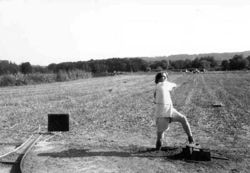
Schwingen, also known as Swiss wrestling and natively as Hosenlupf, is a style of folk wrestling native to Switzerland, more specifically the pre-alpine parts of German-speaking Switzerland. Wrestlers wear Schwingerhosen with belts that are used for taking holds. Throws and trips are common because the first person to pin his or her opponent's shoulders to the ground wins the bout.
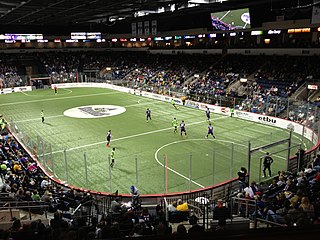
Indoor soccer or arena soccer is a five-a-side or six-a-side version of minifootball, derived from association football and adapted to be played in walled hardcourt indoor arena. Indoor soccer, as it is most often known in the United States and Canada, was originally developed in these two countries as a way to play soccer during the winter months, when snow would make outdoor play difficult. In those countries, gymnasiums are adapted for indoor soccer play. In other countries the game is played in either indoor or outdoor arenas surrounded by walls, and is referred to by different names.
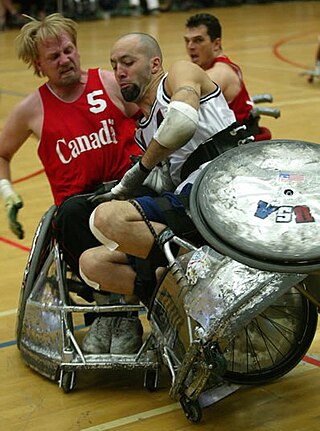
Wheelchair rugby is a team sport for athletes with a disability. It is practiced in over twenty-five countries around the world and is a summer Paralympic sport.
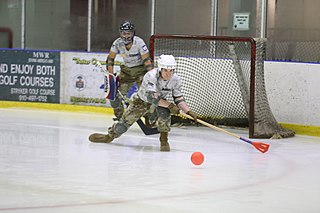
Broomball is a both a recreational and organized competitive winter team sport played on ice or snow and is played either indoors or outdoors, depending on climate and location. It is a ball sport and is most popularly played in Canada and the United States.

Tchoukball is an indoor team sport, played by teams of 7 players. It was developed in Switzerland in the 1970s, and is most popular in Singapore, Switzerland and Taiwan, but has become an international sport with national federations in over 60 countries. It is governed by the International Tchoukball Federation (FITB), which was founded in 1971.

Oină is a Romanian traditional bat-and-ball game, similar in many ways to baseball.

Kho kho is a traditional Indian sport that dates to ancient India. It is the second-most popular traditional tag game in the Indian subcontinent after kabaddi. Kho kho is played on a rectangular court with a central lane connecting two poles which are at either end of the court. During the game, nine players from the chasing team are on the field, with eight of them sitting (crouched) in the central lane, while three runners from the defending team run around the court and try to avoid being touched. Each sitting player on the chasing team faces the opposite half of the field that their adjacent teammates are facing.

Cycle polo, bicycle polo, or bike polo is a team sport, similar to traditional polo, except that bicycles are used instead of horses. There are two versions of the sport: Hardcourt Bike Polo and grass court bike polo. The hardcourt game saw a sharp spike in interest in the first decade of the 21st century and new teams are sprouting up across the world in China, Canada, Ireland, Switzerland, France, India, Germany, Pakistan, Ukraine, Russia, Malaysia, Sri Lanka, Indonesia, Hungary, Australia, New Zealand, Sweden, England, Scotland, Argentina, Italy, Spain, United States, Poland, Croatia, Slovenia, Lithuania, Nepal, Brazil and Cuba.
In games and sport, a tiebreaker or tiebreak is used to determine a winner from among players or teams when their scores are tied at the end of a contest, or a set of contests.
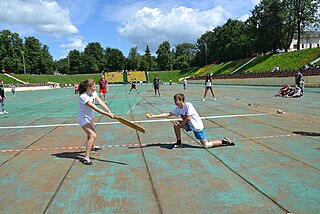
Lapta is a Russian folk game of the bat-and-ball type, first known to be played in the 14th century.
The 2006 Basel hooligan incident occurred on 13 May 2006 in Basel, Switzerland. On that day hooligans supporting the Swiss football club FC Basel 1893 stormed the field of St. Jakob-Park after a championship-deciding match against FC Zürich. Zürich scored in the dying moments of the match and won 2–1. The goal ended a chance for Basel to win the Swiss Super League for a third time in a row. This resulted in property damage and riots between hooligans of both teams' supporters after the match, an incident considered one of the worst incidents involving hooliganism in Swiss sport to date. 115 people, including police, were injured, with 15 hospitalizations.
Several sports related to volleyball have become popular. Indoor volleyball and beach volleyball are both events at the Olympics, and sitting volleyball is an event at the Paralympics. Other varieties are localized, or are played at an amateur or informal level.
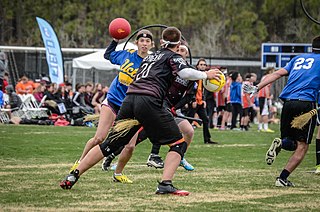
Quidditch, officially known as quadball since 2022, is a team sport that was created in 2005 at Middlebury College in Middlebury, Vermont, United States, and was inspired by the fictional game of the same name in the Harry Potter books by the author J. K. Rowling. Two teams of seven players each, astride broomsticks and opposing each other on a rectangular pitch, compete with the primary objective of passing a ball through the defenders' hoops, while preventing their opponents from passing it through their own hoops. The real-world sport is sometimes referred to as "muggle quidditch" to distinguish it from the fictional game of the books, which involves magical elements such as flying broomsticks and enchanted balls—a muggle in the Harry Potter series being a person without magical abilities. The sport is played around the world.
The following is an alphabetical list of terms and jargon used in relation to Gaelic games. See also list of Irish county nicknames, and these are very interesting.

Kin-Ball is a team sport created in Quebec, Canada, in 1986 by Mario Demers, a physical education professor.

Wheelchair Football is a fast-paced sport that is best played when athletes are in maximum physical condition, and at the top of their game in teamwork, strategy and wheelchair-handling skills, for both manual wheelchair and power wheelchair users. In 2020, the USA Wheelchair Football League was launched by Move United, in partnership with the Bob Woodruff foundation and National Football League, and is launching in Chicago, Los Angeles, Phoenix and Kansas City, Missouri.

Association football was first codified in 1863 in England, although games that involved the kicking of a ball were evident considerably earlier. A large number of football-related terms have since emerged to describe various aspects of the sport and its culture.
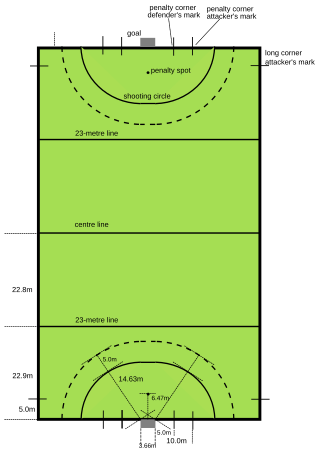
A hockey pitch is the playing surface for the game of field hockey. Historically, the game was played on natural turf (grass) and nowadays it is predominantly played on an artificial turf. The transition to artificial pitches came during the 1970s and was made mandatory for major competitions in 1976. All the lines, markings and goal specifications are outlined by the International Hockey Federation in "The Rules of Hockey".

The 2016–17 FC Basel season is the 124th season in club history and the club's 22nd consecutive season in the top flight of Swiss football. Basel are the reigning Swiss Super League champions. They prepared their season with various warm-up matches against teams from Germany, Russia and France as well as from Switzerland. The 2016–17 Swiss Super League season started on the week-end 23/24 July, the last round was played on 2 June 2017. Basel started with a home game against Sion.
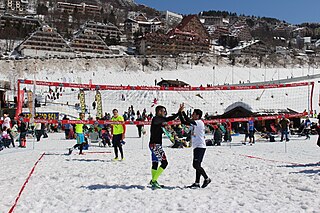
Snow volleyball is a winter team sport played by two teams of three players on a snow court divided by a net. The objective of each team is to score points by sending a ball over the net so as to ground it on the opponent's court, and to prevent the same effort by the opponent. A team is allowed up to three touches to return the ball across the net, and individual players may not touch the ball twice consecutively.

